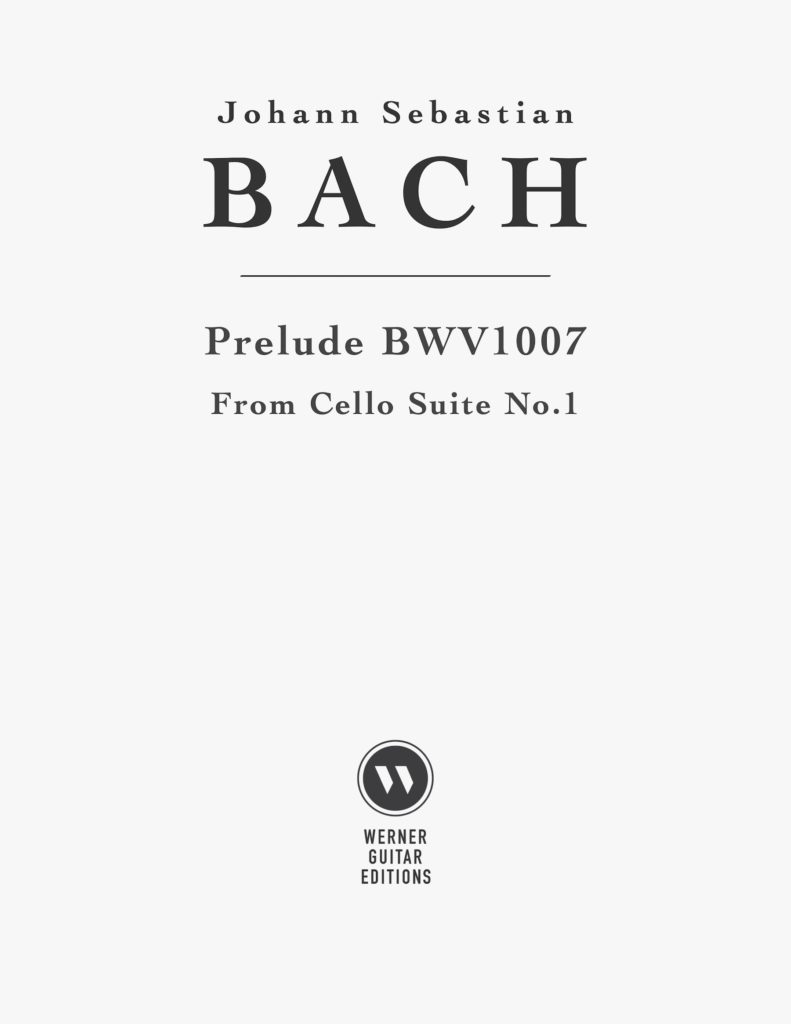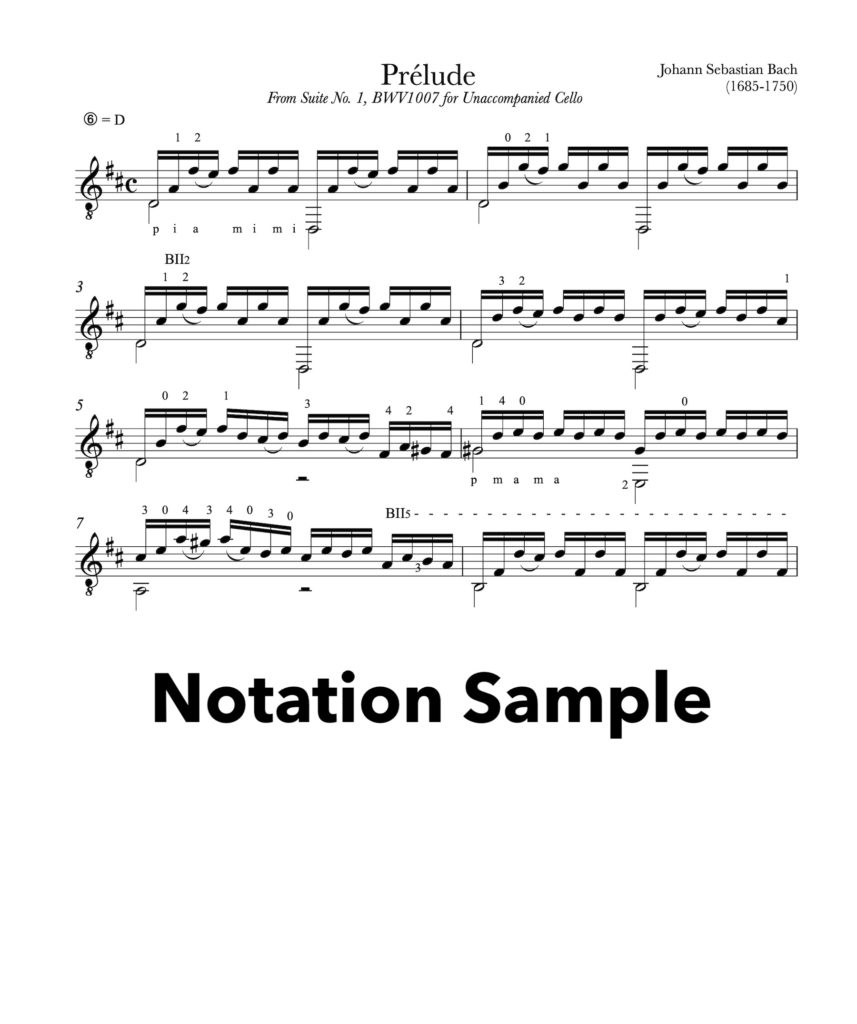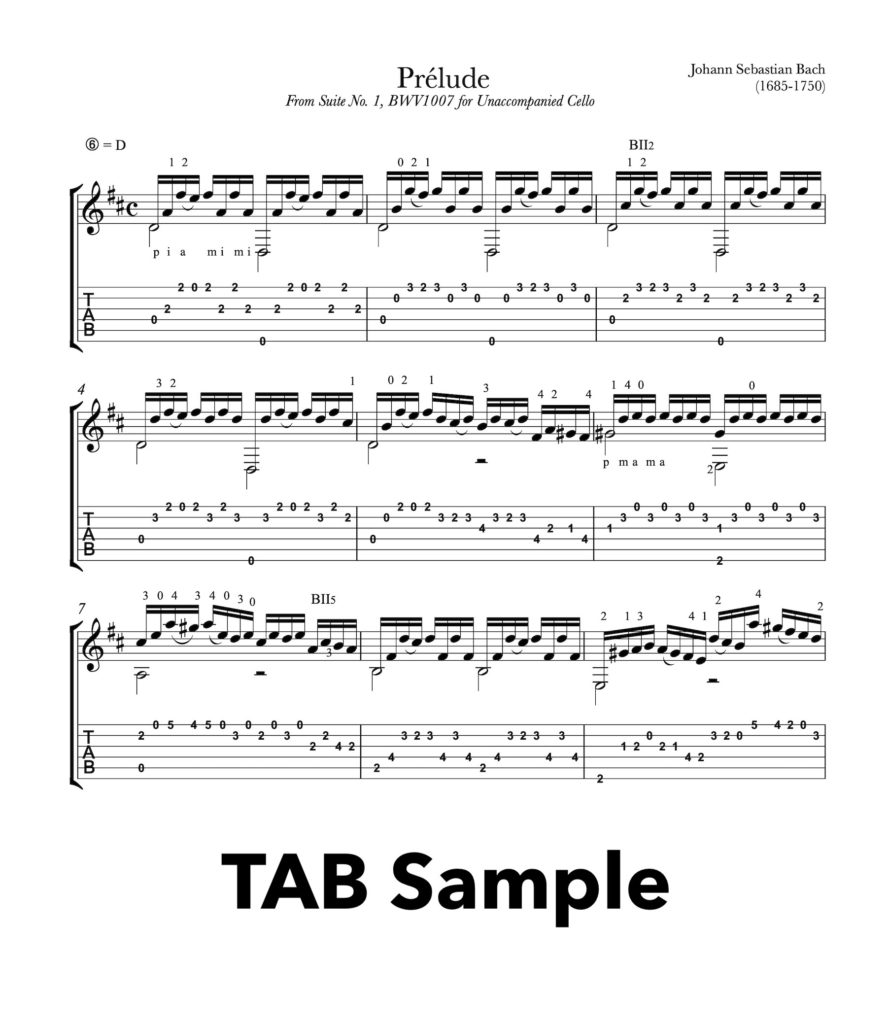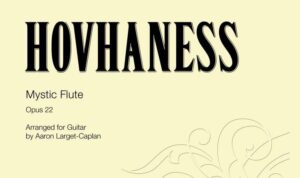Prelude from Cello Suite No. 1, BWV 1007 by Johann Sebastian Bach (1685-1750) – PDF sheet music for classical guitar with free video lesson and performance. Includes both a notation-only edition and a tab edition. Prelude edited for guitar in D Major. Originally in G Major for Unaccompanied Cello. The level is around Late-Intermediate (Grade 7).
My PDF Sheet Music Edition
I’m offering a few editions here: a free unfingered edition, fully fingered notation edition, tab edition, and two non-editorial editions of the entire suite so players can compare their scores to the originals. This iconic work is great for performance and also a favourite for gigs and weddings, in particular, the signing. You can have a free pdf unfigerned edition here. Here’s the YouTube Lesson Link if you want to watch it there.
Samples



Free Non-Editorial Score (Entire Suite) – Presented in treble clef and transposed to alternate keys. No fingerings or unnecessary octave transpositions. Useful as a reference, comparison score, a basis for your own arrangement, or a simple clean score for performance. However, I would recommend you look at an editorial edition or consult your teacher if you are not comfortable making informed decisions about Bach on the guitar. I don’t consider this an “edition” at all, just a transposed facsimile.
- Non-Editorial Version: Bach Cello Suite No. 1, D Major
- Non-Editorial Version: Bach Cello Suite No. 1, C Major
Free Cello Score References for errors and bowings/slurs:
For bowings and other reference please see the following editions. Students are highly encouraged to look at bowing for clues as to how they contribution to interpretation, articulation, and motivic and compositional devices used by Bach.
Cello Suites: Bach-Gesellschaft PDF
Bach-Gesellschaft Ausgabe, Band 27.1 (pp.59-94)
Leipzig: Breitkopf & Härtel, 1879. Plate B.W. XXVII (1).
Editor: Alfred Dörffel (1821-1905)
Cello Suites: Anna Magdalena Bach Copy PDF
Manuscript, n.d.
Public Domain
D B Mus. ms. Bach P 269
Cello Suites: Johann Peter Kellner Copy PDF
Manuscript, n.d.(ca.1726).
Kassel: Bärenreiter, No.5215/5216, 2000.
Public Domain
More versions/editions can be found at:
http://imslp.org/wiki/6_Cello_Suites,BWV_1007-1012(Bach,_Johann_Sebastian)





Very helpful lesson and I appreciate your tempo for both pedagogical and aesthetic purposes. You mentioned that listening to Bach’s cantatas could help inform our understanding and playing of Bach’s music on the guitar. Are there particular cantatas you would recommend as a starting point or as especially helpful? TIA.
Mark
No specific one, I have my favourites such as BWV 67 but they are all somewhat similar if you are not familiar with them.
Many thanks. I’m looking forward to my ‘journey’ through the cantatas. Mark
I notice you have a sort of mat draped over your left leg. Is this a form of friction, to stop the (lacquered) guitar from sliding away, and compromising playing position?
On my Fender Bass, I strapped a cut-up rubber soap dish with little suckers on, specifically as a friction pad to stop it sliding forward and it works well – but looks odd. I haven’t dared to insult my Cordoba C12 the same way, though there is a need for some sort of friction pad, as the acoustic is rather more unwieldy than the Bass.
So is it friction, or is it just protection for the finish of the guitar?
Cheers.
Friction, it’s just shelving cloth. I list some on my Gear Page.
Beautiful piece and beautifully played, one of my favorites of Bach’s. Thanks for putting this one out there.
Just a couple observations Bradford that I wonder if you could comment on?
1. Many performances I’ve seen play at a much faster tempo. Your performance, is this the normal tempo you would play in a performance? Did you slow it down a bit for us students? Just wondering….
2. The run at the end, many performers pick up tempo and volume to create a very strong, vibrant, powerful finish to the piece. Here, you keep it soft and maintain your tempo. It’s really beautiful how you play it, with a subtleness and sweetness to it that is endearing. Again just curious on your thoughts about the different ways performers finish the piece?
Again thanks Bradford for this wonderful interpretation.
Thanks!
1. Can I say yes to both? It’s certainly a relaxed tempo, some people hear this work as a virtuosic toccata but I’m more on the side of an improvisatory “prelude” in the older fashion of an exploratory unfolding of harmony within the key and context of the suite as a whole. That said, I often try to present solid musical foundations when teaching pieces so students understand the strengths of have a solid beat structure and tempo that is maintained. Also, I’m not exactly sight-reading the piece but I don’t really play it myself so I could certainly improve upon my interpretation.
2. I think the musical elements (the melodic line, imitation, pedal point, etc) are highlighted more without getting too carried away with the tempo and ‘showing off’ but, I could easily be convinced otherwise by a good performance that incorporates accelerando.
To your last comment on point 1, a slower tempo allows the notes to ring out a little longer. I think it sweetens the sound, particularly the pull offs. So, no Brad I don’t think you can improve upon the interpretation. It stands out in a field crowded with faster interpretations and does particularly well on its own.
And as I work on this myself I try to replicate your tempo, which is so smooth. Very well done.
Thanks so much for the transcriptions. I just learned the 1st suite, Prelude (in C). I was listening to Rostropovich playing it, and heard a disagreement at measure 26. I was going to comment and let you know that you made an error, but then I Googled it and discovered that your version is correct, and the error was his (based on a commonly accepted edition). Thanks again.
Good catch.
There is a version by E. Pujol.